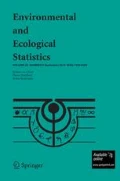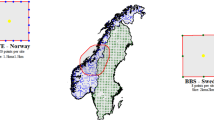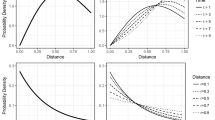Abstract
Not all environmental processes are observed in a way that allows a straight forward easy modelling. Nevertheless, insights can also be gained by exploring weakly dependent covariates paying attention to details of the distribution. Using the concept of copulas, it is possible to explore the dependence of a multivariate distribution without the distortion of the marginal distribution functions acting on typical correlation measures. Furthermore, copulas turn the attention to the dependence across the entire range of the multivariate distribution and do not only summarise it in a single correlation measure. In our application, we study counts of rat sightings in the city of Madrid. The brown rat lives with mankind and adversely affects public health by transmission of diseases, bites and allergies. Better understanding behavioural and spatial correlation aspects of this species can contribute to its effective management and control. We explore weakly to moderately correlated covariates based on distances to broken sewers, feeding grounds and markets as well as population density. The use of copulas is motivated by the different dependence structures of the four covariates and the asymmetries therein. In order to deal with the discrete zero-inflated counts, we present a new approach that assigns conditional random ranks to discrete data. This way, we mimic an underlying continuous variable easing the vine copula estimation, but do not destroy the dependence as in a uniform randomisation. We show that a 5-dimensional vine copula model is able to capture the dependence in our application.









Similar content being viewed by others
Notes
Available from R-forge: https://r-forge.r-project.org/projects/spcopula/.
References
Aas K, Czado C, Frigessi A, Bakken H (2009) Pair-copula constructions of multiple dependence. Insur Math Econ 44:182–198
Bedford T, Cooke RM (2002) Vines—a new graphical model for dependent random variables. Ann Stat 30(4):1031–1068
Bücher A, Kojadinovic I (2016) An overview of nonparametric tests of extreme-value dependence and of some related statistical procedures. CRC Press Inc, Boca Raton
Cressie NA (1993) Statistics for spatial data. Wiley series in probability and statistics. Wiley, Hoboken
Dissmann JF, Brechmann EC, Czado C, Kurowicka D (2013) Selecting and estimating regular vine copulae and application to financial returns. Comput Stat Data Anal 59(1):52–69
Dobson AJ, Barnett A (2008) An introduction to generalized linear models. CRC Press, Boca Raton
Genest C, Nešlehová J (2007) A primer on copulas for count data. Astin Bull 37(02):475–515
Hobæk Haff I, Aas K, Frigessi A (2010) On the simplified pair-copula construction—simply useful or too simplistic? J Multivariate Anal 101(5):1296–1310
Hofert M, Kojadinovic I, Maechler M, Yan J (2015) Copula: multivariate dependence with copulas. http://CRAN.R-project.org/package=copula, r package version 0.999-13
Kojadinovic I (2017) Some copula inference procedures adapted to the presence of ties. Comput Stat Data Anal 112:24–41
Kuethe TH, Hubbs T, Waldorf B (2009) Copula models for spatial point patterns and processes. In: 3rd World conference of the spatial econometrics association, Barcelona, Spain, 9–10 July, 2009. http://econ.ucsb.edu/~doug/245a/Papers/Spatial
Langton S, Cowan D, Meyer A (2001) The occurrence of commensal rodents in dwellings as revealed by the 1996 english house condition survey. J Appl Ecol 38:699–709
Nelsen RB (2006) An introduction to copulas, 2nd edn. Springer, New York
Nikoloulopoulos AK (2013) Copula-based models for multivariate discrete response data. In: Durante F, Hardle W, Jaworski P (eds) Copulae in mathematical and quantitative finance, lecture notes in statistics. Springer, New York, pp 231–249
Nikoloulopoulos AK, Karlis D (2009) Modeling multivariate count data using copulas. Commun Stat Simul Comput 39(1):172–187
Panagiotelis A, Czado C, Joe H (2012) Pair copula constructions for multivariate discrete data. J Am Stat Assoc 107(499):1063–1072
Pappadà R, Durante F, Salvadori G (2016) Quantification of the environmental structural risk with spoiling ties: is randomization worthwhile? Stochastic environmental research and risk assessment, pp 1–15. doi:10.1007/s00477-016-1357-9
Quy RJ, Cowan DP, Haynes PJ, Sturdee AP, Chalmers RM, Bodley-Tickell AT, Bull SA (1999) The Norway rat as a reservoir host of cryptosporidium parvum. J Wildl Dis 35(4):660–670
R Core Team (2016) R: a language and environment for statistical computing. R foundation for statistical computing, Vienna, Austria. http://www.R-project.org/
Schepsmeier U, Stoeber J, Brechmann EC, Graeler B, Nagler T, Erhardt T (2016) VineCopula: statistical inference of vine copulas. https://github.com/tnagler/VineCopula, R package version 2.0.5
Sklar A (1959) Fonctions de répartition á n dimensions et leurs marges. Publ Inst Stat Univ Paris 8:229–231
Tamayo-Uria I, Mateu J, Diggle P (2014) Modelling of the spatio-temporal distribution of rat sightings in a urban environment. Spatial Stat 9:192–206
Zeileis A, Kleiber C, Jackman S (2008) Regression models for count data in R. J Stat Softw 27(8):1–25
Acknowledgements
We thank Ibon Tamayo-Uria, Manuel Garcia and Jose Maria Camara for their invaluable help and in all cases the Technical Unit Vectors Madrid for their cooperation. Two reviewers and the associated editor raised important points that re-shaped the study and considerably improved the manuscript. Carlos Ayyad and Jorge Mateu have been partially funded by Grants P1-1B2012-52 and MTM2013-43917-P. The research of Benedikt Gräler has partially been funded by the German Research Foundation (DFG PE 1632/4-1).
Author information
Authors and Affiliations
Corresponding author
Additional information
Handling Editor: Pierre Dutilleul.
Rights and permissions
About this article
Cite this article
Gräler, B., Ayyad, C. & Mateu, J. Modelling count data based on weakly dependent spatial covariates using a copula approach: application to rat sightings. Environ Ecol Stat 24, 433–448 (2017). https://doi.org/10.1007/s10651-017-0379-x
Received:
Revised:
Published:
Issue Date:
DOI: https://doi.org/10.1007/s10651-017-0379-x




